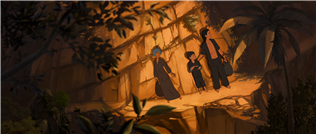“Funan” (currently in limited release) represents GKids’ best shot at an animated Oscar nomination this season. The exquisite 2D feature took both the Annecy and Animation Is Film festivals last year, advancing the potential of animation to reach us with poetry and empathy, with its harrowing story of a family’s struggle to survive the Khmer Rouge reign of terror in Cambodia from 1975-79. In particular, the fierce courage of a mother (voiced by “The Artist’s” Bérénice Bejo) to rescue her lost four-year-old son and escape to freedom.
For first-time director Denis Do, “Funan” became a personal journey of discovery about his own family’s connection to Cambodia, prying loose his mother’s secret about escaping from Cambodia to Paris, where he was born and brought up and where he attended the prestigious Gobelins animation school. “I wanted to tell my mother’s story since graduating from animation school in 2009, but I knew I first needed experience working in film and TV and to raise the financing,” he said. “It took seven years to make with the support of my French producer, Sébastien Onomo [as a co-production with artists from Cambodia, France, Luxembourg, and Belgium].”
But first Do had to take a deep dive into Cambodia and his mother’s painful memories of forced exile into an internment camp and torture. He visited the country three times: In 1995, where he was shaken by the sight of tanks and soldiers in the streets and by the extreme poverty; in 1997, with his mother and little brother, cut short by an attack on the city and escape to Vietnam; and, in 2010, for a scouting trip with his mother, when he was able to fill in the necessary details of authenticity.
“Funan”
GKids
“When I was a kid, my mom never told me the truth about the Khymer Rouge,” Do said. “She only talked about black silhouetted men, which inspired me to draw as a youngster. After the research, I understood more about violence and tragedy and the great migration from Cambodia to other countries. Animation came very slowly, it was a testing ground for my drawing. But later I realized the storytelling potential as a craft without limitation.”
Yet there was the utter beauty of Cambodia that drew the animator closer to his subject and its themes. “It’s a very magnetic country in terms of colors, and I fell in love with that as I discovered Cambodia. So it was obvious to me that I should render the beauty of this country and share it. For example, it is very flat and the consequence of that is that when you are in the middle of a field, the sky is very wide. You feel completely insignificant. But it is not a painful feeling. To me, it’s a bit more spiritual and you feel more in touch with the environment and nature. And the film is built around that. I chose at the beginning to split the human world and nature.
“For example, we have closeups on the characters who are separated from the backgrounds, and, on the opposite side, we have very wide landscapes, and when there are characters in there, of course, they are very small. Sometimes nature and humans were crossed together, but just for a while, and they split again. And only through the perspective of the little boy. Because when we are children, we are much more open-minded, free from manipulation, and able to reach nature. That is why he is able to play with some lizards and frogs. But later on, animals disappear from the film, when he enters the adult world. This is the beginning of the brain washing from the Khymer Rouge. And nature and the human world never cross anymore. Except at the end, when a last breath of air blows into nature.”
“Funan”
GKids
Survival, according to Do, is about changing one’s pre-existing psychology, and that’s what he attempted to convey with his animated depiction of life under the Khymer Rouge. But it’s a fiction inspired by the testimonies he collected from his mother and others, and the animation allowed him to create a new reality, to rebuild everything through drawing and to form a stronger, more intimate connection than through live action.
“The main theme for me is the insignificance of life [under this tyranny], but how it still persists,” said Do. “And I split the screen into two equal parts — characters and landscape — they survive but are very small. This film should be significant in some way for a new generation, like me, born outside of Cambodia, trying to find our own story, our own identity, our own origin, and this story is a way of engaging the process. Emotionally, animation has no border, and this film is about humanity.”
Source: Read Full Article



